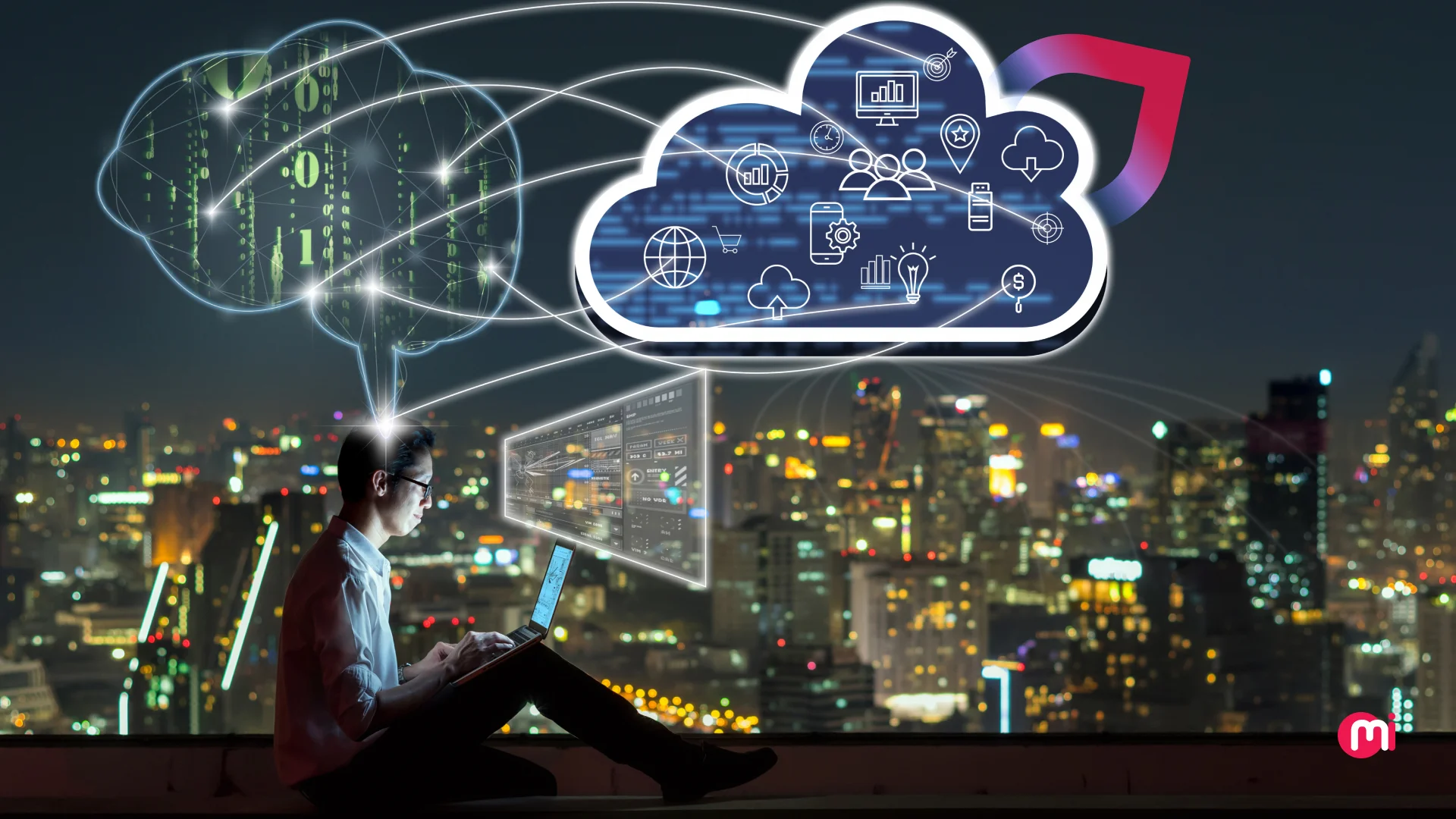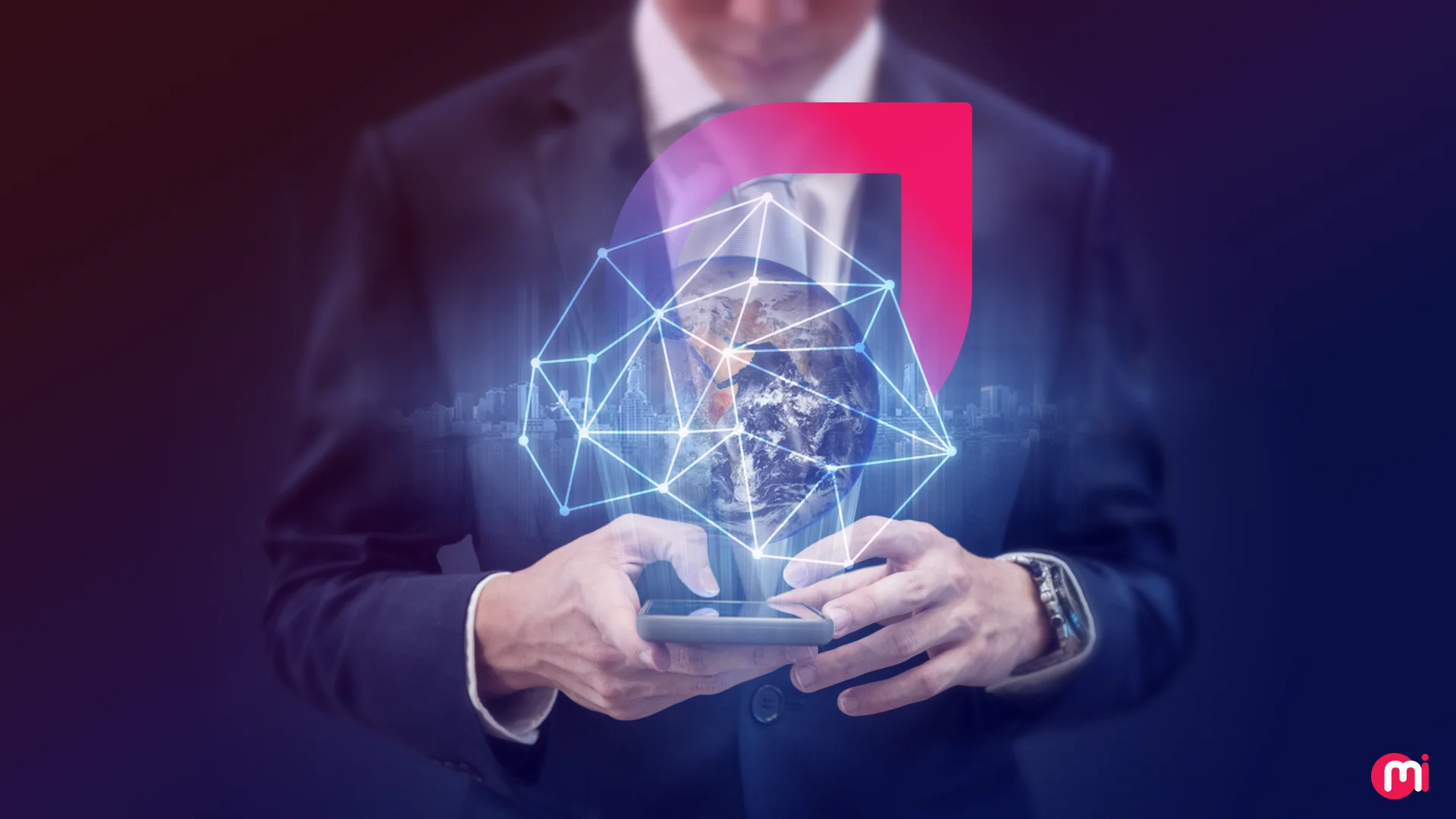The Future of Cloud Computing: How Enterprises Can Leverage it for Scalable Growth?
- Business
- January 16, 2025
With cloud infrastructure spending expected to reach $1.35 trillion by 2027, cloud computing is becoming an integral part of enterprise growth strategies. Now, the only question that remains is which aspects of cloud computing technology enterprises can leverage to meet their requirements. This blog post provides a sneak peek into the future of cloud computing, offering a compilation of trends and how enterprises will benefit from its adoption.
In today’s era of technological evolution, we’ve reached a stage where some solutions simply cannot exist without the cloud or would require enterprises to invest in prohibitively expensive on-premises infrastructure.
Consider these examples:
- Global-scale video streaming platforms: Netflix, YouTube, etc.
- SaaS solutions: Salesforce, HubSpot, etc.
- Autonomous driving solutions: Tesla’s Autopilot, Waymo, etc.
- AI/ML services: ChatGPT, AWS SageMaker, etc.
- Real-time collaboration tools: Google Workspace, Slack, etc.
- On-demand services: DoorDash, Zomato, etc.
These solutions have become so integral to our lives that we can hardly imagine a world without them, nor can the enterprises behind them.
Enterprises are in the middle of the transition right now. We often refer to it as digital transformation or legacy system modernization. At the heart of this transition lies the cloud, one of the most significant enablers of enterprise technology.
If you ask what are the options that your enterprise can consider. Well, this blog is designed to serve this purpose. We have compiled a list of trends that are anticipated to shape the cloud computing future.

What Is The Future Of Cloud Computing?
As technology evolves, so does cloud computing. It is often manifested in the trends that emerge at any given time, each representing the best solutions to address the specific challenges of that period.
Today, enterprises face the pressing need to move beyond outdated legacy systems, and the current cloud computing trends offer the solutions necessary to achieve this transformation.
Below are key developments shaping the future of cloud computing, offering enterprises the tools and strategies needed to modernize their infrastructure, enhance performance, and achieve scalable growth.
1. Cloud Adoption
This value expected to be generated from cloud adoption could be the manifestation of IT savings, operational cost savings, and risk reduction, which can roughly translate to around $873 billion in EBITDA.
Apart from this majorly the value that enterprises grab can also be from revenue improvement due to the use of advanced analytics, automation, accelerated product development, hyper-scalability, and more, roughly could be around $2.3 trillion in EBITDA, whereas innovation-driven growth can lead to last $612 billion out of the $3 trillion.
2. Hyperconnected Cloud Ecosystems
A step beyond isolated cloud solutions.
Imagine a cohesive and dynamic digital enterprise environment where your systems, processes, infrastructure, and people are seamlessly connected to facilitate real-time collaboration. This level of integration is powered by interoperability between disparate systems, accomplished through APIs, cloud integration platforms, data fabric architectures, and more. Not only cloud services from multiple providers, it enables enterprises to have seamless integration of on-premises systems and third-party applications.
The result is a truly unified ecosystem that connects all elements of the enterprise, whether they exist in the cloud or on-premises.
By leveraging it, enterprises can benefit from omnichannel collaboration, enhanced operational agility, real-time data flow across diverse environments, and improved customer responsiveness globally.
| 📈 Future stance of hyperconnected ecosystem trend: The global hyperconnectivity market is forecasted to grow significantly, reaching a value of USD 999.86 billion by 2031, up from USD 279.35 billion in 2024. This growth represents a robust compound annual growth rate (CAGR) of 20% over the forecast period. |
3. Hybrid and Multi-Cloud Environments
With more and more enterprises seeking resilience, flexibility, and substantial cost optimization in cloud enablement, hybrid and multi-cloud approaches have become a conscious choice, and their presence in infrastructure strategy is dominating among modern organizations.
Let’s explore how both add value to enterprise growth with different examples.
Say for example, you are a financial institution using a hybrid cloud. It empowers your institution to choose private clouds for compliance-sensitive data while leveraging public clouds for customer-facing applications like chatbots or online portals.
Whereas your institution can also opt to run critical workloads on AWS while using Google Cloud for advanced AI capabilities. It helps your institution to dodge vendor lock-ins and high availability.
Having said it all, Multi cloud vs Hybrid cloud still remains a constant dilemma for enterprises.
| 📈 Future stance of hybrid and multi-cloud adoption trend: As mentioned in cloud computing statistics compiled by MindInventory, approximately 73% of enterprises have adopted a hybrid cloud strategy as of 2024, while 47% of organizations are planning to incorporate multi-cloud infrastructure in the near future. In terms of market size growth, the hybrid cloud market is expected to grow significantly, reaching USD 430.12 billion by 2030 from USD 158.37 billion in 2025, with a compound annual growth rate (CAGR) of 22.12%. The multi-cloud management market is projected to grow from USD 8.61 billion in 2023 to USD 50.04 billion by 2030, reflecting a CAGR of 28.6% |
4. Integration of AI and ML in Cloud Services
Cloud computing plays a critical role in enabling AI/ML as a service, AI/ML tools or features. These solutions support features like chatbots, recommendations, personalized experiences, and intelligent automation. This helps enterprises to use this next-gen technology to make their software solutions more efficient.
Enterprises can benefit from ensuring compliance, especially in regulated industries like finance and healthcare, predictive analytics, generating actionable insights, automating repetitive tasks, and more.
| 📈 Future stance of AI/Ml in the cloud: The cloud AI market is seeing rapid growth. Projections indicate a significant upward trajectory, with the market expected to rise from USD 60.35 billion in 2023 to USD 397.81 billion by 2030 with a CAGR of 30.9% during the 2023–2030 period. Similarly, the global cloud AI market is anticipated to expand substantially, growing from USD 80.30 billion in 2024 to USD 327.15 billion by 2029. This suggests a robust CAGR of 32% over the next five years, reinforcing the increasing importance of AI-driven cloud solutions in businesses worldwide |
5. Fog and Edge Computing
We are seeing a rise in IoT devices lately, especially in industries that benefit from real-time decision-making. With the increase in these devices, the volume of data generated at the edge of networks also increases, necessitating efficient processing closer to its source. This is not possible with traditional cloud computing models, as they face latency issues due to the need to send data to centralized data centers. This makes these models unsuitable for time-sensitive applications and software.
Does this mean your enterprise would suffer?
Not necessarily, because this is where Edge and Fog computing come in. Edge computing facilitates localized data processing, either by using the devices themselves or local servers. However, scalability could be a potential bottleneck.
Fog computing extends Edge computing further by adding a middle layer of computing power between edge devices and the cloud, creating a distributed, hierarchical computing model. This intermediate layer, often referred to as “fog nodes,” brings several additional capabilities that enhance the power and scalability of edge computing.
By processing data at the edge, enterprises can achieve faster response times, improved performance, and reduced reliance on centralized data centers. It also allows for real-time monitoring and predictive maintenance. Especially in industries where milliseconds matter (e.g., autonomous vehicles or financial trading), this trend helps reduce latency significantly, increasing safety and precision.
| 📈 Future stance of Edge and Fog computing trend: The edge computing market is projected to grow from USD 16.45 billion in 2023 to USD 155.90 billion by 2030, with a strong compound annual growth rate (CAGR) of 36.9%. Meanwhile, the fog computing market is expected to see significant growth, from USD 440.75 million in 2025 to USD 12.2 billion by 2033, reflecting a CAGR of 51.46%. |
6. Serverless Computing
Serverless computing, also referred to as ‘Function as a Service (FaaS),’ is more than just a trend; it’s a revolution in how enterprises approach infrastructure, application deployment, and scaling. It helps enterprises to leave behind the hassles of server provisioning or management. Its pay-for-value billing model is a major draw, as enterprises only pay for the computing resources they actually use.
Leveraging serverless models empowers enterprises to reduce operational overhead, avoid over-provisioning costs, scale seamlessly from zero to peak demand, accelerate development cycles, and benefit from built-in cloud services.
As enterprises shift toward more agile and cost-efficient IT strategies, serverless computing will undoubtedly play a pivotal role in shaping the future of enterprise technology.
| 📈 Future stance of serverless computing trend: The serverless computing market is set to grow significantly, with projections estimating an increase from USD 21.9 billion in 2024 to USD 44.7 billion by 2029, reflecting a compound annual growth rate (CAGR) of 15.3%. |
7. Service Mesh
If you are an enterprise seeking service-level observability or service-level control, adopting a service mesh is the right choice. The centralized infrastructure layer it provides gives you intricate details into service-to-service communication within a distributed application.
How do enterprises benefit from service mesh?
The benefits range from enhanced resilience due to advanced traffic management to load balancing, service discovery, security, monitoring, and more. In a nutshell, it simplifies the complexities of inter-service communication while ensuring security, reliability, and observability.
| 📈 Future stance of service mesh trend: The service mesh market is expected to grow from USD 0.22 billion in 2023 to USD 5.05 billion by 2032, reflecting a compound annual growth rate (CAGR) of 41.3%. This growth highlights the increasing adoption of service mesh architectures as businesses seek to improve microservices management, scalability, and security. |
8. Cybersecurity Beyond Perimeter Defence
Let’s face it! We are far beyond the point where traditional perimeter-based security for software solutions is sufficient.
The rise of distributed systems, remote workforces, and sophisticated cyberattacks has made this abundantly clear. Modern cybersecurity threats require a shift toward more comprehensive, proactive, and adaptive security measures.
To mitigate cyber risks, enterprises are adopting Zero Trust Architecture (ZTA), threat detection using AI, Secure Access Service Edge (SASE), Cloud Security Posture Management (CSPM), and more. Apart from it, adopting cloud security best practices also can help enterprises to protect the sensitive user data.
By leveraging these approaches, enterprises can build resilient systems. This ensures the security of sensitive data across distributed cloud environments, minimizes downtime, reduces costs associated with data breaches, and instills confidence in customers and partners.
| 📈 Future stance of cybersecurity: As per the statistics market insights, the global cybersecurity market is projected to reach USD 203.00 billion by 2025, with security services expected to dominate, accounting for USD 103.10 billion of the market. This growth is expected to continue at a compound annual growth rate (CAGR) of 7.58%, reaching USD 271.90 billion by 2029. |
9. Cloud-Native Modernization
Organizations today are focusing on more flexible, scalable, and agile systems to meet dynamic customer expectations—something that is increasingly difficult to achieve with traditional monolithic architectures, legacy systems, and outdated tech ecosystems.
The way forward? Cloud-native modernization.
It involves transforming traditional IT systems into architectures optimized for cloud environments, with key aspects including microservices architecture, containerization, CI/CD pipelines, serverless computing, and more.
With holistic modernization or cloud migration strategy, enterprises become capable of responding swiftly to market demands and customer expectations. The other cloud computing benefits include cost savings due to pay-as-you-go pricing models, improved productivity through the use of automation tools and modern development practices, minimized downtime thanks to decentralized and containerized systems, and positioning your enterprise as agile, customer-centric, and future-ready.
| 📈 Future stance of cloud-native modernization trend: The cloud-native applications market, valued at USD 7.06 billion in 2023, is expected to grow at a CAGR of 23.8% from 2024 to 2030. Additionally, the global application modernization services market is projected to a robust growth rate of 16.7% CAGR by 2030. The cloud-native storage market, valued at USD 16.02 billion in 2023, is also expected to reach USD 93.27 billion by 2032, growing at a CAGR of 22.94% |
10. Green Cloud Initiatives
Reducing your carbon footprint while achieving cost savings might seem like a dream, but for companies committed to renewable energy, green cloud initiatives make it a reality.
Why are carbon footprints raising concerns?
Data centers are highly energy-intensive. Both data centers and data transmission consume a substantial amount of energy, accounting for 1–1.5% of global electricity usage.
Enterprises can opt for cloud service providers like Google Cloud and Microsoft Azure, who are committing to net-zero emissions by leveraging clean energy sources. Other green cloud initiatives or practices could include optimizing workload scheduling, adopting cloud-native strategies, and more.
Furthermore, enterprises can consider opting for batch processing, meaning scheduling non-critical workloads during periods of low energy demand to reduce electricity usage. This approach can also earn you brownie points with eco-conscious consumers, investors, and regulators.
| 📈 Future stance of green cloud initiative trend: The global green data center market, valued at USD 49.2 billion in 2020, is projected to grow to USD 140.3 billion by 2026, reflecting a CAGR of 19.1%. Similarly, the cloud sustainability market is expected to expand from USD 30.28 billion in 2024 to approximately USD 175.82 billion by 2034, growing at a steady CAGR of 19.23%. |
11. Global Decentralized Infrastructure
Historically, enterprises have relied on centralized data centers to manage and process their data, but now the scenario has changed. Enterprises are shifting toward decentralized infrastructure.
The need for data security, lower latency, higher availability, and the rise of blockchain technology has led to a growing interest in decentralization. The key aspects driving the wide adoption of this approach are data sovereignty, resilience, redundancy, transparency, and more.
A global decentralized infrastructure comprises distributed cloud networks, blockchain-enabled cloud solutions, edge and fog computing integration, and Decentralized Autonomous Organizations (DAOs).
By adopting it, enterprises can eliminate the possibility of single points of failure. Further, they benefit from optimized bandwidth usage, better resource allocation, reduced latency costs, alignment with regional data sovereignty laws, safeguards against data breaches, improved business continuity, and more.
Last but not least, this technology helps create tamper-proof audit trails, which is not only critical but also a requisite in industries like finance or supply chain.
| 📈 Future stance of decentralized infrastructure trend: The global decentralized identity market, valued at USD 647.80 million in 2022, is expected to grow at a staggering CAGR of 90.3% from 2023 to 2030. The Blockchain in the Infrastructure market is expected to grow significantly, with projections indicating an increase from USD 27.39 billion in 2025 to USD 221.35 billion by 2034, reflecting a compound annual growth rate (CAGR) of 26.11% during this period. In 2024, the market size was valued at USD 21.72 billion. Similarly, the Web 3.0 blockchain market is forecasted to expand from USD 3.74 billion in 2023 to USD 98.3 billion by 2032, growing at a CAGR of 43.8%. |
Accelerate Your Digital Transformation with MindInventory’s Cloud Computing Expertise
Experience the next level of cloud computing with MindInventory. We are the leading provider of end-to-end cloud engineering solutions. We help businesses harness the full potential of the cloud with AI/ML, data analytics, and serverless computing, ensuring faster time-to-market and more efficient operations.
The MindInventory Advantage:
- Experience in implementing industry-specific cloud computing solutions.
- Experience with cloud platforms like AWS, Microsoft Azure, Google Cloud, and Oracle Cloud.
- Knowledge of cloud architecture principles (e.g., microservices, serverless computing, multi-cloud, hybrid cloud)
- Strong focus on data protection, regulatory compliance (GDPR, HIPAA, PCI-DSS), and industry-specific security protocols
- Integration with existing on-premise data systems, IoT devices, and third-party APIs
- Familiarity with tools like Jenkins, GitLab, Docker, Kubernetes, Terraform, and more
Our goal is to make your cloud journey seamless, enabling you to scale operations, enhance security, and accelerate innovation at every step. Contact us to start your cloud transformation journey. Let’s build your cloud strategy together.
FAQs on Future of Cloud Computing
There is no debate as to whether or not the cloud reduces the cost of owning and maintaining large data centers, but it’s not just that. However, this narrow view overlooks the broader, more transformative potential of the cloud. In today’s scenario, it is one of the key tools for business enablement. It facilitates agility, speed, scalability, business continuity, global reach, market expansion, security, compliance, and more.
To maximize value from the cloud, it’s essential to go beyond simply moving workloads to the cloud and focus on addressing key technological challenges that will enable sustained, long-term success. This could include building CSP-specific foundational services, choosing the right approach for application migration, creating resiliency patterns, implementing security-as-code protocols, and more.
The major types of cloud computing include Public Cloud, Private Cloud, Hybrid Cloud, and Multi-Cloud. When choosing between them, it really depends on your business needs. If you’re looking for cost-effective scalability and don’t mind using shared resources, Public Cloud is a great option. If your focus is on security and control, then a Private Cloud would suit you best. For businesses that need the flexibility of both, a Hybrid Cloud allows you to have the best of both worlds. Lastly, if you want to avoid being tied to one provider and ensure better resilience, Multi-Cloud can be the way to go.













